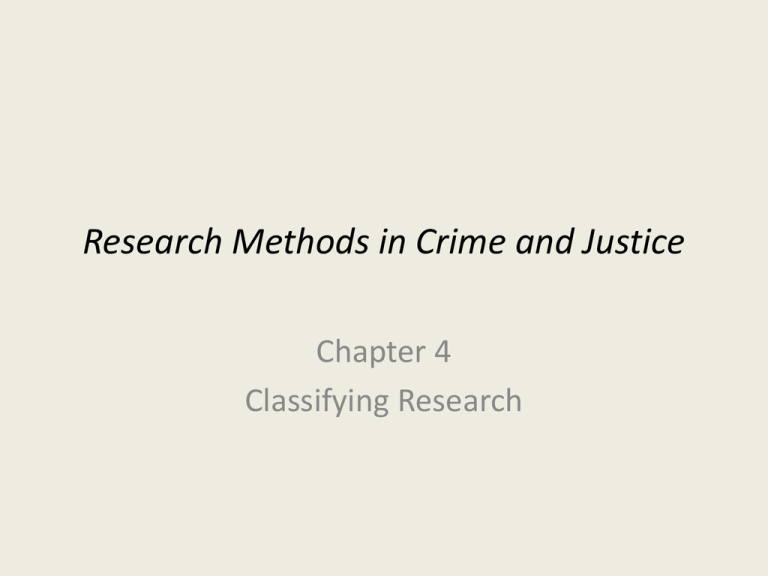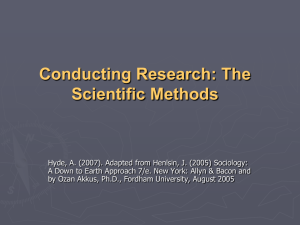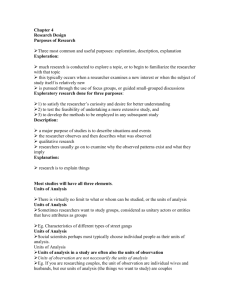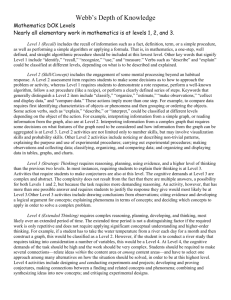Research Methods in Crime and Justice
advertisement

Research Methods in Crime and Justice Chapter 4 Classifying Research Why Classify Research? • Research is often classified into categories. – To enhance our ability to access the literature efficiently. – To enable researchers to evaluate research. – To understand the limitations of a research project. – There are six commonly used schemes for classifying research. Why Classify Research? • Researchers should avoid discounting research based solely on its classification. • All classifications of research contribute to our understanding of social phenomena. • No single classification of research is ‘better’ than another. • Instead the quality of research should be based on how well the researcher adhered to generally accepted research methods. Paradigms of Research • A paradigm is a general organizing framework for social theory and empirical research. • A lens through which a person views social phenomena. • A paradigm reflects a researcher’s assumptions about reality. • There are three commonly used paradigms of research. Paradigms of Research • Positivist social science inquiry relies on empirical observations and may attempt to establish a causal relationship between variables. • Interpretive social science inquiry attempts to measure human behavior by developing an understanding of its meaning. • Critical social science inquiry is based on the assumption that research is not value free and that every researcher brings his or her own particular biases into the research process. The Purpose of Research • Research may be classified in terms of its purpose. • Every research project has a primary purpose. • Most research projects have multiple purposes. • There are three common purposes of research. The Purpose of Research • Exploratory research attempts to learn something about a new or emerging social phenomenon. • Descriptive research attempts to describe social behavior or phenomena. • Explanatory research attempts to explain why individuals or groups behave the way they do. The Time Dimension of Research • Research can be classified in terms of its time dimension. • The time dimension of research refers to the span of time during which the data were collected. • There are two commonly used time dimensions of research. The Time Dimension of Research • Cross-sectional research uses data collected at a single point in time. • Longitudinal research uses data collected over an extended time frame. – Trend studies collect the same data at different times from different samples of the same population. – Panel studies collect the dame data at different times from the same sample. – Cohort studies collect data from groups of individuals that share a common characteristic or experience. The Nature of Data • Research may be classified by the nature of the data it uses. • The nature of the data is defined by how the concepts are measured. • There are two common ways that researchers measure concepts. The Nature of Data • Quantitative research measures variables numerically. It assumes that the social world can be understood objectively and measured accordingly. • Qualitative research examines variables in a natural social setting and probes the qualitative meaning of these variables. It assumes that the social world is best understood subjectively, or from the perspective of research subjects. Method of Reasoning • Research may be classified by the method of reasoning used by the researcher. • The method of reasoning is determined by where the researcher begins the inquiry. • There are two commonly used methods of reasoning. Method of Reasoning • Deduction or deductive reasoning begins with a theory and collects data (makes observations) that either supports or falsifies the theory. • Induction or inductive reasoning begins with data (or observations) and then seeks to develop a theory that explains that behavior. Unit of Analysis • Research may be classified by its unit of analysis. • The unit of analysis is determined by the ‘what’ or ‘whom’ from which a researcher collects data. • A unit of analysis can be an individual, a group, an organization or even an entire nation. Logical Errors • An understanding of a research project’s unit of analysis enables a researcher to identify potential logical errors. – An ecological fallacy occurs when a researcher predicts individual behavior based solely on observations gathered from a group of similar individuals. – Reductionism occurs when a researcher predicts group behavior based solely on an observation of an individual from that group. Getting to the Point • Research is often organized by different classification methods in order to help researchers access it more efficiently and evaluate its strengths and limitations. Getting to the Point • Researchers often approach research questions from a particular paradigm or perception of social reality. • These perceptions affect how the researcher conducts the research and, in many cases, the outcome of the research findings. • The positivist, interpretive and critical paradigms all contribute to our understanding of social phenomena. Getting to the Point • Research is often conducted for a specific purpose. – Exploratory research provides initial insight into new or emerging social phenomena or behavior. – Descriptive research describes existing social phenomena or behavior. – Explanatory research explains why individuals or groups behave the way they do. • It is not uncommon for a single research project to serve more than one purpose. Getting to the Point • Cross-sectional research involves data collection at one point in time. • The findings from this research cannot be used to draw conclusions about change over time. • But they can provide a snapshot of a social condition or population at that point in time. Getting to the Point • Longitudinal research utilizes data that are collected over a period of time. • The findings from this research indicate how a social condition or particular population changes over time. Getting to the Point • Quantitative research measures variables numerically and assumes that the social world can be understood objectively. • Qualitative research probes the meaning of variables and assumes that the social world is best understood subjectively, often from the perspective of the research subject. Getting to the Point • Deductive reasoning begins with a theory that explains social behavior and uses observations to test the theory. • Inductive reasoning begins with observations of social behavior and uses those observations to develop a theory that explains the behavior. Getting to the Point • The unit of analysis is the ‘what’ or ‘whom’ about which researchers gather information during a research project. • A unit of analysis can be an individual, a group, a community, a state or even an entire nation. Getting to the Point • An ecological fallacy occurs when a researcher makes a prediction about how an individual might behave based on data collected at the group level of analysis. • Reductionism occurs when a researcher makes a prediction about how a group might behave based on data collected at the individual level of analysis. Research Methods in Crime and Justice Chapter 4 Classifying Research







